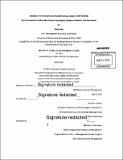| dc.contributor.advisor | Christian Catalini. | en_US |
| dc.contributor.author | Yang, Yang, S.M. Massachusetts Institute of Technology | en_US |
| dc.contributor.other | Sloan School of Management. | en_US |
| dc.date.accessioned | 2015-09-29T18:56:54Z | |
| dc.date.available | 2015-09-29T18:56:54Z | |
| dc.date.copyright | 2015 | en_US |
| dc.date.issued | 2015 | en_US |
| dc.identifier.uri | http://hdl.handle.net/1721.1/98986 | |
| dc.description | Thesis: S.M. in Management Research, Massachusetts Institute of Technology, Sloan School of Management, 2015. | en_US |
| dc.description | Cataloged from PDF version of thesis. | en_US |
| dc.description | Includes bibliographical references (pages 58-67). | en_US |
| dc.description.abstract | Since the establishment of the first P2P lending platform in 2005, P2P lending industry has been nibbling the market share of traditional consumer credit. In 2014, Lending Club and Prosper originated over 7 billion personal loans. As one of the biggest traditional banks in the U.S., Citi issued 25.2 billion USD in 2014. Given the advantages of P2P lending over traditional banks, the market for P2P lending is expected to grow rapidly along with the improvement of the internal system of P2P lending platforms, external regulation and more participation from borrowers and lenders. Given the fact that most P2P lending platforms in China first imitated the business model from either the U.S. or European platforms, they have progressively evolved to incorporate different business models due to legislation, economic or behavioral reasons. Several findings are detected by analyzing the data form Lending Club and Prosper. First, although both platforms progressively improve the default rate each year, currently both platforms offer negative returns for investors. Second, if only considering finished/matured loans, higher credit score doesn't lead to less default risk. Third, on average, a default loan will cost a loss more than twice as much as the interest return offered to investors. Taking this cost matrix into consideration, the optimal data model won't necessarily provide the highest accuracy but maximum return. Fourth, the ex post return offered by the platforms is not enough to cover the potential risk facing investors. | en_US |
| dc.description.statementofresponsibility | by Yang Yang. | en_US |
| dc.format.extent | 67 pages | en_US |
| dc.language.iso | eng | en_US |
| dc.publisher | Massachusetts Institute of Technology | en_US |
| dc.rights | M.I.T. theses are protected by copyright. They may be viewed from this source for any purpose, but reproduction or distribution in any format is prohibited without written permission. See provided URL for inquiries about permission. | en_US |
| dc.rights.uri | http://dspace.mit.edu/handle/1721.1/7582 | en_US |
| dc.subject | Sloan School of Management. | en_US |
| dc.title | Analysis and assessment of credit rating model in P2P lending : an instrument to solve information asymmetry between lenders and borrowers | en_US |
| dc.type | Thesis | en_US |
| dc.description.degree | S.M. in Management Research | en_US |
| dc.contributor.department | Sloan School of Management | |
| dc.identifier.oclc | 921177765 | en_US |
